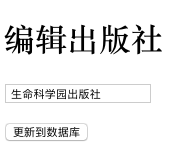我们可以先定义数据表的结构
创建一个出版社的id和name(models.py文件)
# 出版社 class Publisher(models.Model): # 自增的主键id id = models.AutoField(primary_key=True) # 创建一个varchar(64)的唯一的不为空的字段 name = models.CharField(max_length=64, null=False, unique=True)
将改动记录下来
python manage.py makemigrations
去数据库执行
python manage.py migrate
然后可以通过pycharm中的database工具进行数据库的编辑
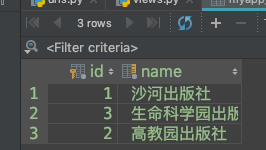
下一步就是建立url对应关系(urls.py)
from django.conf.urls import url from django.contrib import admin from myapp import views urlpatterns = [ url(r'^admin/', admin.site.urls), # 出版社列表 url(r'^publisher_list/', views.publisher_list), ]
去views.py文件中建立publisher_list函数
函数内部要完成的功能是
- 去数据库查询出所有出版社,
- 填充到html中,
- 返回给用户
from django.shortcuts import render, HttpResponse from myapp import models def publisher_list(request): ret = models.Publisher.objects.all()
# 输出一个列表对象[<Publisher: Publisher object>, <Publisher: Publisher object>, <Publisher: Publisher object>] # print(ret[1].id, ret[1].name) #id和名字拿出来了 #render渲染页面 #在publisher_list.html页面通过publisher_list变量就可以获取到ret了 return render(request, "publisher_list.html", {"publisher_list": ret})
在templates目录下新建publisher_list.html文件来进行展示给用户
<table border="1"> <thead> <tr> <th>id值</th> <th>name</th> </tr> </thead> <tbody> {% for publisher in publisher_list %} <tr> <td>{{ publisher.id }}</td> <td>{{ publisher.name }}</td> </tr> {% endfor %} </tbody> </table>
- 特殊的模板循环语言
这样运行django项目,访问对应的url就可以看到将数据表的信息展示出来了
在浏览器页面的内容如下(http://127.0.0.1:8000/publisher_list/):
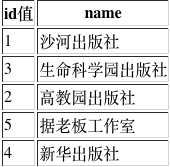
然后我们可以在页面添加功能,比如:添加出版社, 删除出版社, 编辑出版社
添加出版社
1,在urls.py文件中添加对应URl对应关系
# 添加出版社 url(r'^add_publisher/', views.add_publisher),
2,在views.py中创建对应的逻辑函数
# 添加出版社 def add_publisher(request): if request.method == "POST": # 用户填写了新的用户名,并发送了post请求过来 new_publisher = request.POST.get('new_publisher') if new_publisher: # 去数据库中创建一条数据库记录 models.Publisher.objects.create(name=new_publisher) else: return HttpResponse("出版社名字不能为空") # 添加成功之后将publisher_list页面返回给用户 return redirect('/publisher_list/') # 点击添加用户时,返回一个页面,有个框,用于添加数据 return render(request, "add_publisher.html")
3在templates目录下建立add_publisher.html用于添加出版社页面
<!DOCTYPE html> <html lang="en"> <head> <meta charset="UTF-8"> <title>出版社列表</title> </head> <body> <a href="/add_publisher/">添加出版社</a> <table border="1"> <thead> <tr> <th>id值</th> <th>name</th> <th>操作</th> </tr> </thead> <tbody> {% for publisher in publisher_list %} <tr> <td>{{ publisher.id }}</td> <td>{{ publisher.name }}</td> <td> <a href="/delete_publisher/?id={{ publisher.id }}">删除</a> <a href="/edit_publisher/?id={{ publisher.id }}">编辑</a> </td> </tr> {% endfor %} </tbody> </table> </body> </html>
这样就完成了添加出版社的功能了
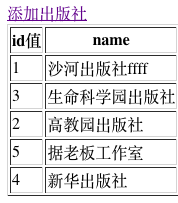

接下来就是删除出版社的功能(根据id来删除)
urls.py中
# 删除出版社 url(r'^delete_publisher', views.delete_publisher),
views.py中
# 删除出版社 def delete_publisher(request): # 删除制定的数据 # 1从GET请求的参数里面拿到将要删除的id值 delete_id = request.GET.get('id',None) # 如果能够获取到数据 if delete_id: # 根据id值查找到数据 delete_obj = models.Publisher.objects.get(id=delete_id) # 删除 delete_obj.delete() # 返回删除后的页面,跳转到出版社的列表页,查看是否删除成功 return redirect("/publisher_list/") else: return HttpResponse("要删除的数据不存在")
现在就可以删除数据了,点击删除就会在数据库中删除数据
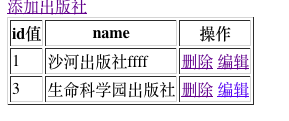
接下来就是编辑功能了(用来实现更改出版社的name)
urls.py文件
# 编辑出版社 url(r'^edit_publisher', views.edit_publisher),
views.py文件
# 编辑出版社 def edit_publisher(request): # 用户修改完出版社的名称,点击提交,在这里获取到 if request.method == "POST": # print(request.POST) #检查post能够获取那些信息 #取新出版社的名字 edit_id = request.POST.get("_id") new_name = request.POST.get("_name") # 根据id,来编辑出版社 edit_publisher = models.Publisher.objects.get(id=edit_id) edit_publisher.name = new_name edit_publisher.save() #更新到数据库 # 跳转到出版社列表页,查看是否修改成功 return redirect("/publisher_list/") # 从GET请求的url中取到id属性 edit_id = request.GET.get("id") if edit_id: # 获取到当前编辑的出版社 publisher_obj = models.Publisher.objects.get(id=edit_id) return render(request, "edit_publisher.html", {"publisher":publisher_obj})
edit_publisher.html文件
<!DOCTYPE html> <html lang="en"> <head> <meta charset="UTF-8"> <title>编辑出版社</title> </head> <body> <h1>编辑出版社</h1> <form action="/edit_publisher/" method="post"> <p> <input type="text" name="_id" value="{{ publisher.id }}" style="display: none"> </p> <p> <input type="text" name="_name" value="{{ publisher.name }}"> </p> <p> <input type="submit" value="更新到数据库"> </p> </form> </body> </html>
最后的效果
